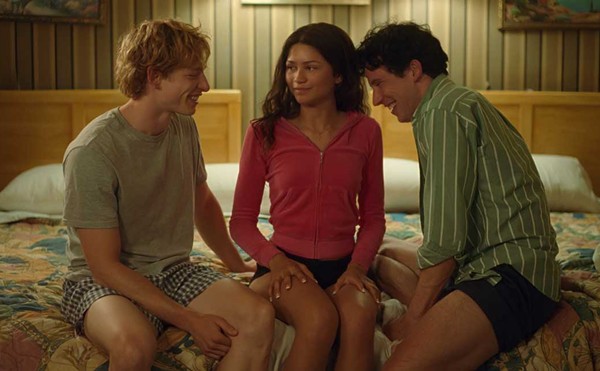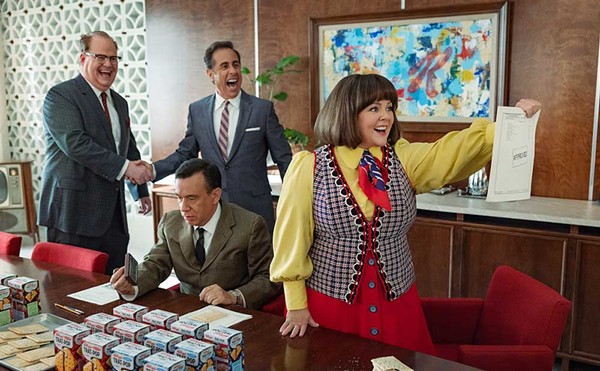Earle Warren Zaidins was in court on Feb. 27, 1963, defending one Leonard Alfred Schneider, aka Lenny Bruce, on obscenity charges stemming from his performance at a Chicago nightspot called the Gate of Horn. The show covered Bruce's usual themes — adultery, war, and the vapidity of organized religion. A police raid had been triggered by one of the comic's signature bits, "Christ and Moses," in which the two holy men unexpectedly stop by St. Patrick's Cathedral, causing a panicked Cardinal Spellman to beg the pope's help. ("We're up to our ass in crutches and wheelchairs here!")
Though the arresting officers listed a number of items in their complaint against Bruce — his liberal use of the words "fuck," "tits," and "balls" among them — it was clearly his God talk that really caused the men in blue to see red. In fact, a week after the arrest, the head of Chicago's vice squad visited the Gate of Horn's owner and threatened him, "If [Bruce] ever speaks against religion, I'm going to pinch you and everyone in here. . . . He mocks the pope — and I'm speaking as a Catholic — I'm here to tell you that your license is in danger."
So, Zaidins walks into a courtroom, defending his Jewish client against charges that his words about Christianity are obscene. It's Ash Wednesday, and, as the new book The Trials of Lenny Bruce describes it, "The judge, the two prosecutors, and all twelve jurors appeared bearing a cross of ash on their foreheads."
Not surprisingly, Bruce was found guilty — simply more evidence to support one of his best quips: "Chicago is so corrupt, it's thrilling."
Absurdity followed Bruce through the last five years of his life, but much of it wasn't funny at all. When it was over, he'd racked up eight misdemeanor obscenity arrests that resulted in six trials in San Francisco, Los Angeles, Chicago, and New York (along with a small handful of drug busts, a side effect of his heroin addiction). He'd lost his health, battling pleurisy, broken bones caused by a fall from a hotel window, and, always, his raging habit. He'd lost his audience, partly because club owners feared the wrath of police and partly because his act was no longer entertaining. His stage time had now shrunken to his obsessive legal rantings, and his deconstructions of social hypocrisies, born in the strip clubs of Eisenhower's America, were rapidly becoming passé in the Age of Aquarius. When he died in 1966, he was broke and had fled a four-month jail sentence on his New York conviction.
Since his death at 40, Bruce has been held up as both comedy's Bob Dylan and its Jesus: He gave spoken-word performers license to spill their unexpurgated guts, and also died for the sins of his uptight times. But does he deserve the canonization? In The Trials of Lenny Bruce, authors Ronald Collins and David Skover, both attorneys and legal scholars, painstakingly dissect Bruce's legal odyssey and, in the process, reveal both how little and how much lies beneath the myths that surround the comic and his crusade for free speech. They note that no important legal precedents emerged from Bruce's many cases — a claim even Larry Flynt, a pornographer with no pretensions to artistry, can make. "In the world of the law," the authors write, "his life and legal struggles are nothing; it is as if he never existed."
However, Collins and Skover found that "there is a great legal story to be told" in Bruce's tale. "It is the story of the poignant and perverse sides of free speech and the way that speech plays to people and power." The book's narrative is supplemented by a CD, narrated by Village Voice columnist Nat Hentoff, that contains Bruce's most litigated routines, snippets of his New York trial that the defendant secretly recorded, and commentary from attorneys on both sides of the cases and from other interested parties, including comic George Carlin — who was busted in the Gate of Horn show audience for failing to surrender his ID, and for being a wise-ass about it.
Collins and Skover are skilled at placing Bruce's struggle in the context of his times and the then-current legal environment, defined by the Supreme Court's 1957 decision in Roth v. United States, which ruled that obscenity was not protected by the First Amendment yet defined obscenity as that which has no socially redeeming value and incites lustful thoughts. But the authors' key interest is in law, not art, and sometimes their pop-culture deficiencies and lack of writerly pizazz are painfully evident. Take this description of Bruce's friend, record producer Phil Spector, please: "Spector was one of the key forces behind the rebel yell of the notorious Ramones, the kickstart punk-rock group that jarred the youth world in the 1970s."
Thus, the authors are not much help in evaluating Bruce as an artist, beyond acknowledging that he was, even in his prime, sometimes not very funny. This is perhaps the most shocking thing today about Bruce — after decades of hearing him name-checked and genuflected to by generations of comics, it's a jolt to hear how pedestrian and obvious his material sounds in the wake of Richard Pryor, Roseanne, Bill Hicks, Margaret Cho, and Chris Rock, original thinkers all. Much sounds downright corny to today's audiences, hitting over and over again the theme that the human body is a groovy thing, man.
In hindsight, Bruce's key talent appears to be sniffing out hypocrisy, his preachiness overlaid with a beatnik veneer. Even when he latched onto a truly revisionist idea — his infamous "Hauling Ass to Save Her Ass" routine, for instance, in which he disputed the conventional wisdom that Jacqueline Kennedy crawled out of the speeding limo where her husband lay dying in order to help a Secret Service man aboard--he sounded merely sour and sanctimonious. He lacked his successors' ability to turn outrage into the catharsis of inclusion and belly laughs, as opposed to merely tittering at the squares.
More inspiring than listening to his actual work is reading how the comic jousted with the repressed mores of his times. It's mind-boggling just how long ago and far away early-'60s America seems in The Trials of Lenny Bruce, with the comic slapped into handcuffs for using words like "schmuck" and "ass"--nothing you can't hear today on network television. At his trials, prosecutors routinely made hay of the fact that Bruce did his blue work in the presence of "adult women" — a laughably pre-feminist concern, not to mention one that ignores the fact that the women, like the men, chose to watch Bruce work. And then there is the blatant melding of church and state: Time and again, it is the comic's God talk, at least as much as his sex talk, that landed him in court.
In that context, it's easy to get caught up in his sheer outlaw chutzpa. In 1962 in San Francisco, in the middle of his first obscenity trial — and only two days after being warned by the judge that using profanity onstage would result in another arrest — Bruce took the stage of the Curran Theatre and mocked the judge by name, in a performance that lasted more than three hours. Go, Lenny, go!
But that come-and-get-me-coppers bravado soon wilted in the face of constant police harassment, and the comic's troubles worsened as he got more deeply involved in his defense. As becomes evident in Trials, Bruce made a lousy client for any lawyer unlucky enough to have been hired by him. He was fond of sending "love letters" to the judges that presided over his trials, his rambling missives alternating between sucking up and veiled threats in an effort to request fairness, a tactic that sometimes earned him contempt citations. In his Chicago and New York trials, he fired his attorneys (partly out of disputes over strategy and partly out of poverty) and served as his own counsel; his defense included such tactics as offering the appearance of his so-called dirty words in the dictionary as proof that they were not obscene. Said Ephraim London, the lead counsel in Bruce's New York trial (until Bruce canned him): "Lenny is a real genius, a near-genius, but the most inept lawyer I've ever run across."
However, the authors suggest, Bruce's lawyers often mounted defenses built upon weak foundations — parading academics, ministers, and journalists before juries and offering up Bruce as a Swiftian satirist, whose use of words like "motherfucker" could be excused in light of community standards because of the overall coherence and artistic merit of his work (a problematic approach to begin with, because of the herky-jerky flow of his bits). Bruce and his lawyers, in essence, sought the imprimatur of the very society his work slammed.
Better, Collins and Skover argue, that his words had been defended as dissident speech — the kind fully protected by the Constitution. Bruce, they write, was both defying community standards and working within the law. "When Lenny was ribald, raunchy, irreverent and tasteless, he was an American standing on his rights," they write. "[U]nder this admittedly bold view of the First Amendment, comedy of that kind never again should be put on trial."
As the book makes clear, not even Bruce (and certainly not his lawyers) were aware of the political import of his highly political work. The Trials of Lenny Bruce is a potent and timely reminder that it's not what you say, but your right to say it, that matters in America.
Heather Joslyn writes for Baltimore City Paper, where this feature first appeared. Send comments to [email protected].





